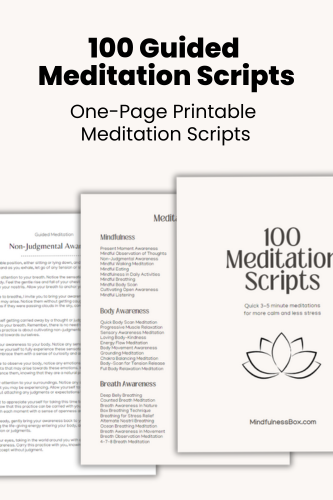Not every meditation technique works perfectly for everyone. From Vipassana to Chakra meditation to Zazen to mantra meditation, there are different types of meditation techniques to experiment with as you look for the practice that best connects with you.
Oftentimes, experienced meditators go through multiple forms of meditation before settling on one that connects best with them, or feels like it has the greatest effect on their daily experience.
These 100 meditation scripts were created to help beginner and intermediate meditators practice key mindfulness concepts like self-love, forgiveness, gratitude, and inner peace.
Designed to fit into busy schedules, each meditation script lasts 3-5 minutes. Perfect for starting or closing a group meditation; for yoga, coaching, or therapy sessions; or for your personal meditation practice.
You might start with concentration meditation, for example, then do a Vipassana retreat, before switching to mantra meditation and experimenting with self-inquiry meditation. This is not an uncommon path.
Or, you may simply want to try different meditation techniques from time to time, as I recommend here, in order to add variety to your practice.
How many types of meditation are there? Dozens, with more variations being added as time goes on. With the incredible number of meditation techniques available, it can be overwhelming to sort through them all. So you might consider just picking one and starting with it, and experimenting as you go. There are no wrong answers!
Feel free to look through this meditation types list below for inspiration:
1. Affirmations

Affirmations are a meditative technique for focusing your awareness and your subconscious on a goal or positive message that you want to reinforce.
For example, you might want to become a more generous and compassionate person, you might repeat each day, “I am generous. I am compassionate.”
For more on affirmations, check out these deep-dives:
2. Ambient Music Meditation
Ambient music is a common choice for people who meditate while listening to music.
It’s often used as a way to block outside noises and distractions during meditation.
3. Binaural Beats Meditation
Binaural beats are a form of brainwave entrainment. Using pulses of sound, binaural beats can help the mind get into a state of relaxation, assisting with meditation.
4. Body Scan Meditation

Body scan meditation involves focusing your awareness on different parts of your body during meditation, centering your focus on your physical experience moment-to-moment.
5. Brainwave Entrainment
Brainwave entrainment is the process of synchronizing multiple beats to become harmonious, and using the resulting soundscape to help the brain enter a relaxed, meditative state. Binaural beats are a common form of brainwave entrainment.
6. Breathing Meditation
Breathing meditation is perhaps the most common form of meditation because of the convenience factor: your breath is always with you.
Focusing your awareness on your breath is a way to stay focused on the present moment, whether you’re meditating or doing any other activity.
A brief guide to 4-7-8 Breathing:
- Close your mouth and inhale quietly through your nose to a mental count of 4.
- Hold your breath for a count of 7.
- Exhale completely through your mouth, making a whooshing sound to a count of 8.
- This is one breath cycle. Now inhale again and repeat the cycle 3 more times for a total of 4 breaths.
- Focus on the numbers and sounds of the breath. If your mind wanders, gently return your attention back to the breath.
- Remember to breathe diaphragmatically, filling your lungs and abdomen not just your chest.
7. Buddhist Meditation
Buddhist teachings are the foundation of modern secular meditation. Buddhist meditation techniques span a variety of traditions, from Vipassana to Zazen, and range from the many types of mindfulness meditation to loving-kindness meditation to contemplative meditation.
A brief guide to Buddhist meditation:
There are many Buddhist meditation techniques. This is a general overview of principles many of them hold in common.
- Sit with a straight back, either on the floor or in a chair.
- Breathe naturally. Focus on the sensation of your breath moving in and out.
- When your mind wanders, note the distraction then redirect your attention back to your breath.
- Practice observing your thought stream without attachment or judgment. Let thoughts arise and pass away.
- Generate loving-kindness by reciting positive phrases like “May all beings be happy and free from suffering.”
- Contemplate the impermanence of all phenomena. Observe how your breath, thoughts, and sensations are constantly changing.
8. Centering Prayer
Centering prayer is a Christian meditative tradition involving focusing on one word, and repeating that word over and over.
The purpose is to clear the mind and allow divine will to be more easily heard.
A brief guide to Centering Prayer:
- Choose a sacred word as the symbol of your consent to God’s presence and action within you.
- Sitting comfortably with eyes closed, settle briefly and silently introduce the sacred word.
- When engaged with thoughts, return ever-so-gently to the sacred word.
- At the end of the prayer period, remain in silence with eyes closed for a couple of minutes.
- Centering prayer emphasizes surrender to God rather than concentration.
9. Chan Meditation
Chan is a form of Buddhism originating in China in the 6th century AD.
Chan meditation is focused on cultivating peaceful energy, purifying the body and reducing anxiety, stress, and anger.
A brief guide to Chan meditation:
- Keep your eyes partially open, with your gaze lowered or unfocused. This helps sustain alert mindfulness.
- Pay attention to your breath as it enters and leaves the nostrils. Follow the sensations of each inhalation and exhalation.
- When thoughts arise, recognize them but don’t engage. Let them go and return to your breath.
- Don’t dwell on judgments, desires or aversions. Simply let them go and return to the breath.
- When you notice you have become lost in thought, gently return your attention to your breathing.
- Avoid strain or effort. Remain relaxed, open and aware.
- Eventually, you can transition to just following the method of “no method” – resting in wakeful presence.
10. Chakra Meditation
A chakra refers to an energy point within your body. According to Hindu tradition, there are seven of them, each corresponding to distinct areas of your body and mind.
Chakra meditation techniques involve focusing on one or more of your seven chakras in order to unblock them.
11. Chanting Meditation
Chanting meditation is a common practice among many religious traditions. The repetition of mantras can help to balance the nervous system while freeing up the mind to focus on the present moment.
12. Children’s Meditation

Meditation has been shown to improve concentration, focus, and academic outcomes in children.
Oftentimes, meditative practices for children take the form of easy-to-understand exercises like the Raisin Mindfulness Exercise, or other sensory practices.
See more mindfulness activities for kids here.
13. Christian Meditation
Christian meditation has been practiced for centuries, frequently in the form of centering prayer and contemplative prayer.
Jesus is described as engaging in meditative prayer in the Bible, often going off to sit alone for hours on end.
14. Compassion Meditation
Compassion meditation is a way to practice feeling love and compassion towards others, and can help with the development of empathy.
15. Concentrative Meditation
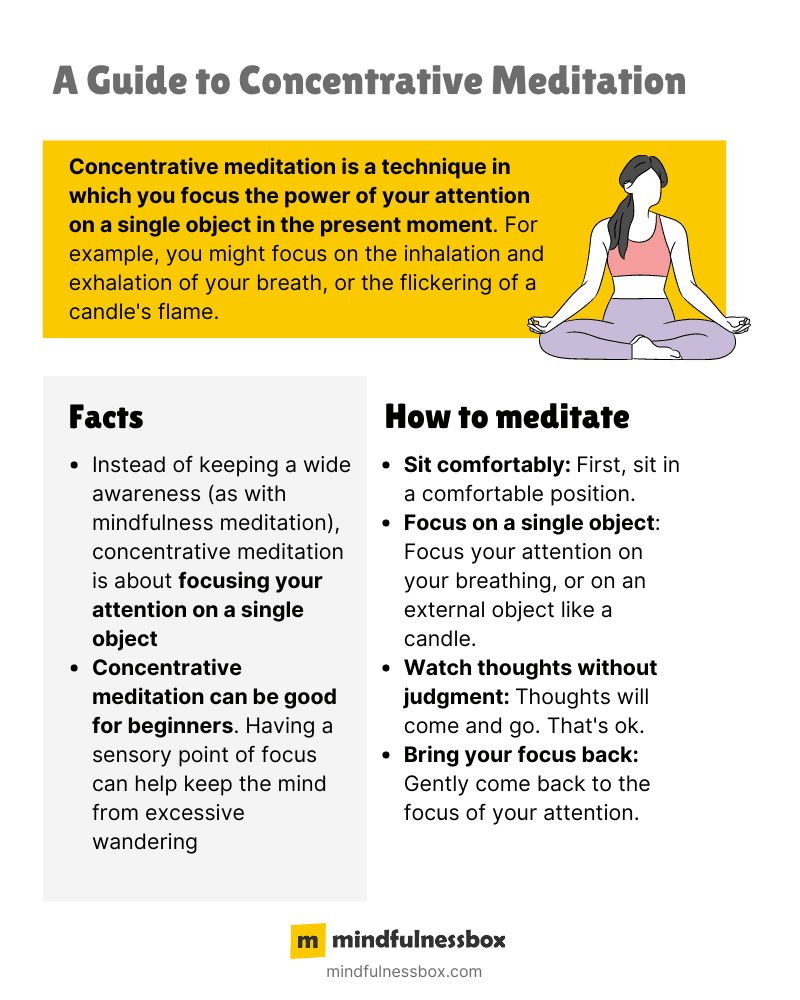
Concentrative meditation uses a single point of attention to keep the mind focused and produce a sense of calm.
The point of attention can be the breath, but any object works. A candle is often used.
16. Contemplative Prayer
A Christian tradition going back centuries, contemplative prayer focuses on creating space and silence for God’s presence to reveal itself in different ways.
Contemplative prayer may start with centering prayer.
17. Drumming Meditation
Drumming meditation is common within certain religious and spiritual communities.
Like mantras, chanting, and binaural beats, the rhythmic sound of drumming can help to reset your energy and bring the mind into a more meditative state.
18. Embodiment Meditation
Embodiment meditation is a way to stay present by focusing on the physical sensations in your body.
Similar to body scan meditations, embodiment meditation helps you to bring yourself more closely in sync with your body, noticing feelings you others might not and using the body as a tool to stay in the present moment.
19. Gratitude Meditation
An extension of compassion meditation, gratitude meditation focuses on sending love and appreciation to everything in your life that you value, from your friends and family to nature to the simple pleasure of being alive.
20. Hindu Meditation
As the spiritual origin of meditation, Hinduism contains many varieties of meditation, from Kundalini meditation to Om meditation.
Oftentimes, Hindu meditation practices are intertwined with the practice of yoga.
21. Insight Meditation
Insight meditation comes from the Vipassana tradition and focuses on observing the senses. In addition to exploring the breath, insight meditation focuses on sensations like smelling, tasting, touching, and hearing.
Mindful eating is a common insight meditation practice, engaging all of the senses.
22. Islamic Meditation
Islamic meditation is typically centered around creating a stillness in the practitioner, in order to connect with the divine.
Sufism is a branch of Islam with a long history of meditative practices.
23. Jewish Meditation
Jewish meditation practices have centuries of history, starting around the 1st century CE within the tradition of Jewish mysticism, and expanding with the Kabbalah, a mystical Jewish tradition.
Rabbi Dr. Benjamin Epstein compares mindfulness to the Jewish concept of Yishuv Hadaas, which is the Jewish imperative to cultivate peace of mind, tranquility, and composure.
24. Kabbalah Meditation
The Jewish tradition of Kabbalah has incorporated meditative practices for centuries, often taking the form of meditating on the names of God or combinations of Hebrew letters.
25. Kundalini Meditation
Kundalini comes from the Hindu tradition of meditation, typically involving visualization, mantras, and breathing exercises.
Kundalini shares traits with Chakra meditation, focusing on opening the chakras and allowing energy to flow.
26. Loving-Kindness (Metta) Meditation
Loving-Kindness meditation comes from the Buddhist tradition.
Its goal is to help the practitioner develop unconditional love, which in turn can relieve anger and suffering and improve well-being.
27. Manifestation

Manifestation is a form of meditation that relies on influencing the many thousands of subconscious thoughts that occur in the mind each day.
By envisioning what you want your life to look like in a year, for example, and reminding yourself of that vision each day, manifestation holds that you can slowly reprogram your mind and beliefs, which affects your actions and leads to your desired outcome.
Learn more at our manifestation guide here.
28. Mantra Meditation
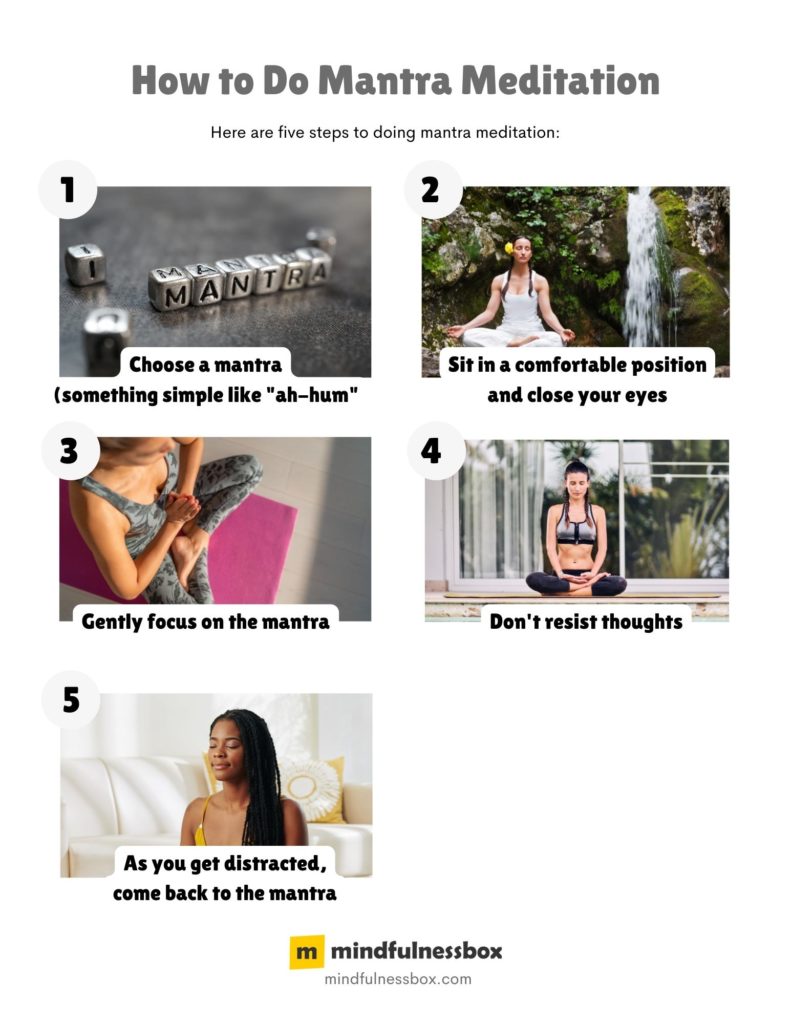
Mantra meditation is a common feature of meditation techniques that come from religious traditions. Often, these mantras were phrases from sacred texts.
They were thought to contain specific sounds intended to induce different states of consciousness. Today, there are also entirely secular forms of mantra meditation.
29. Mindfulness-Based Cognitive Therapy (MBCT)
Mindfulness-Based Cognitive Therapy (MBCT) combines elements of both cognitive behavioral therapy and mindfulness.
MBCT is typically used to treat depression, and has been shown to be especially effective in preventing relapse in those experiencing chronic depression.
30. Mindfulness-Based Stress Reduction (MBSR)
Mindfulness-Based Stress Reduction (MBSR) was developed in 1979 by Jon Kabat-Zinn. It was designed as an 8-week course to help with stress management.
MBSR programs have become a standard way to incorporate mindfulness into scientific research.
31. Mindful Eating
Mindful eating is a form of insight meditation in which you focus on all of the senses involved in the experience of eating: the look, smell, texture, and taste of the food.
Instead of eating quickly, mindful eating is typically slow to give you a chance to stay present for each moment of the experience.
Mindful eating can be a form of changing your relationship with food, or simply an easy way to incorporate mindfulness into your everyday life.
The Raisin Mindfulness Exercise is a common mindful eating practice.
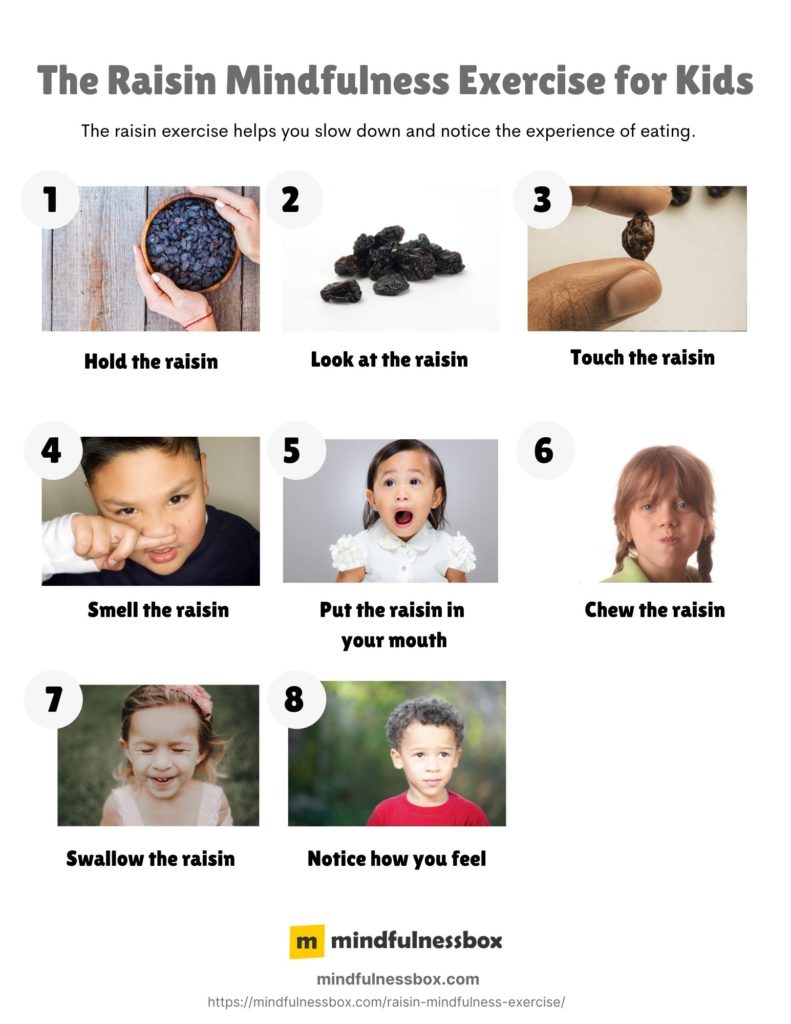
32. Mindfulness Meditation
Mindfulness meditation is a secular form of meditation with its origins in Buddhism.
The focus of the practice is on the present moment, bringing an awareness to the thoughts that pass through your mind and gently acknowledging them before letting them go without judgment.
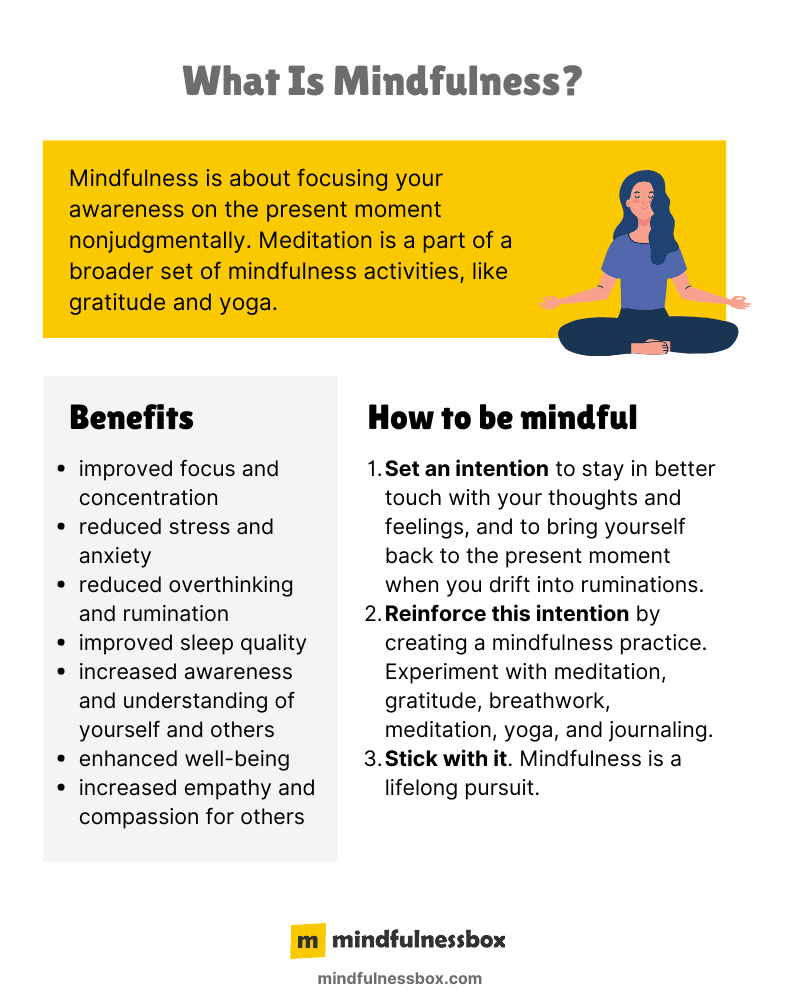
33. Om Meditation
Om Meditation is a form of chanting meditation originating from the Hindu tradition, in which practitioners repeat the word ‘Om.’
The word Om is thought to vibrate at a frequency that connects the mind and body with nature and all things.
34. Open Awareness
Open awareness is a term you may hear often in meditation practices. Rather than focusing your attention on a single point such as the breath or a flickering candle (as in Concentration Meditation), when you meditate with open awareness you allow your attention to go wherever it wants to, observing the results without judgment.
35. Pranayama
Pranayama comes from the yoga tradition, and encompasses a range of breathing techniques that are suitable for yoga as well as meditation. Pranayama contains a range of breathing practices that affect the nervous system in different ways.
36. Primordial Sound Meditation
Similar to Transcendental Meditation and other mantra meditations, Primordial Sound Meditation (PSM) focuses on helping the mind reach a meditative state through the repetition of mantras.
Unique to PSM is the idea that the mantra you chant is connected to the time and location of your birth.
37. Qi Gong
Qi gong is an energy practice that comes from Chinese meditation traditions.
Similar to tai chi, qi gong involves the manipulation of energy through slow, purposeful movement, visualization, and breathing patterns.
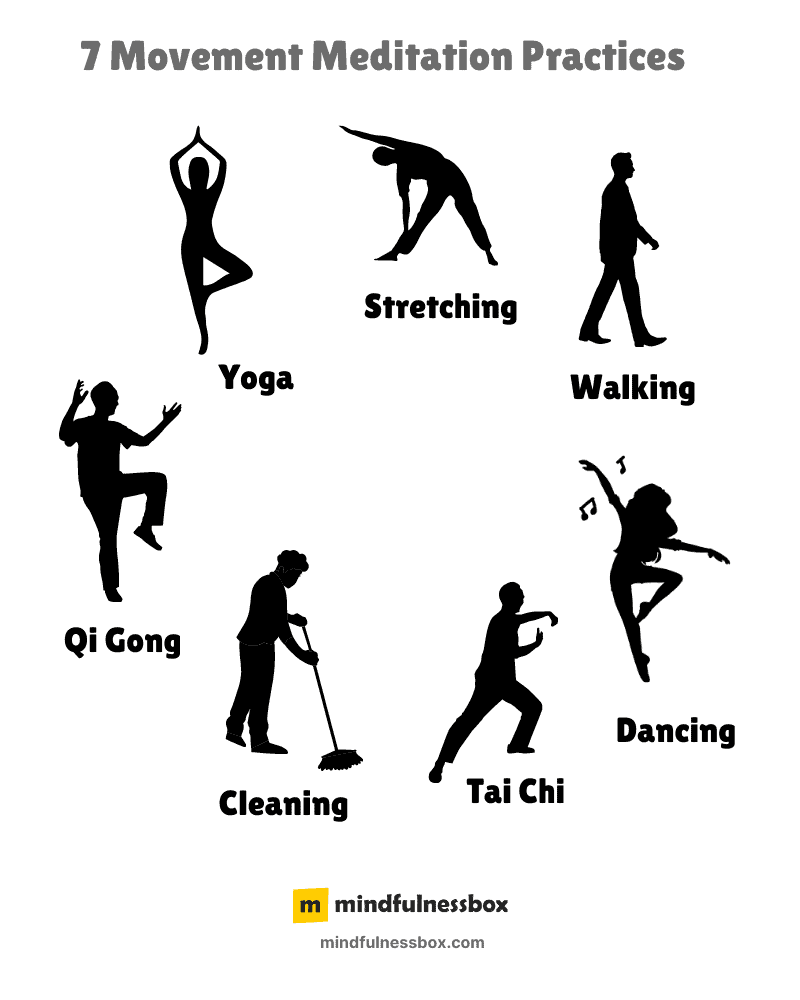
38. Relaxation Meditation
Relaxation meditation is focused on achieving a state of calm and bringing the nervous system into balance.
Rather than an attention or present-moment practice, relaxation meditation is focused on stepping out of your normal stream of thoughts in order to release tension and find a state of relaxation.
39. Self-Inquiry Meditation
Self-Inquiry meditation focuses on transcending the ego by discovering your true nature. This form of meditation centers on asking yourself the question “Who Am I?”
Eventually, after enough inquiry, the thought is that the “I” identity will disappear, and only awareness will remain.
40. Shaolin Meditation
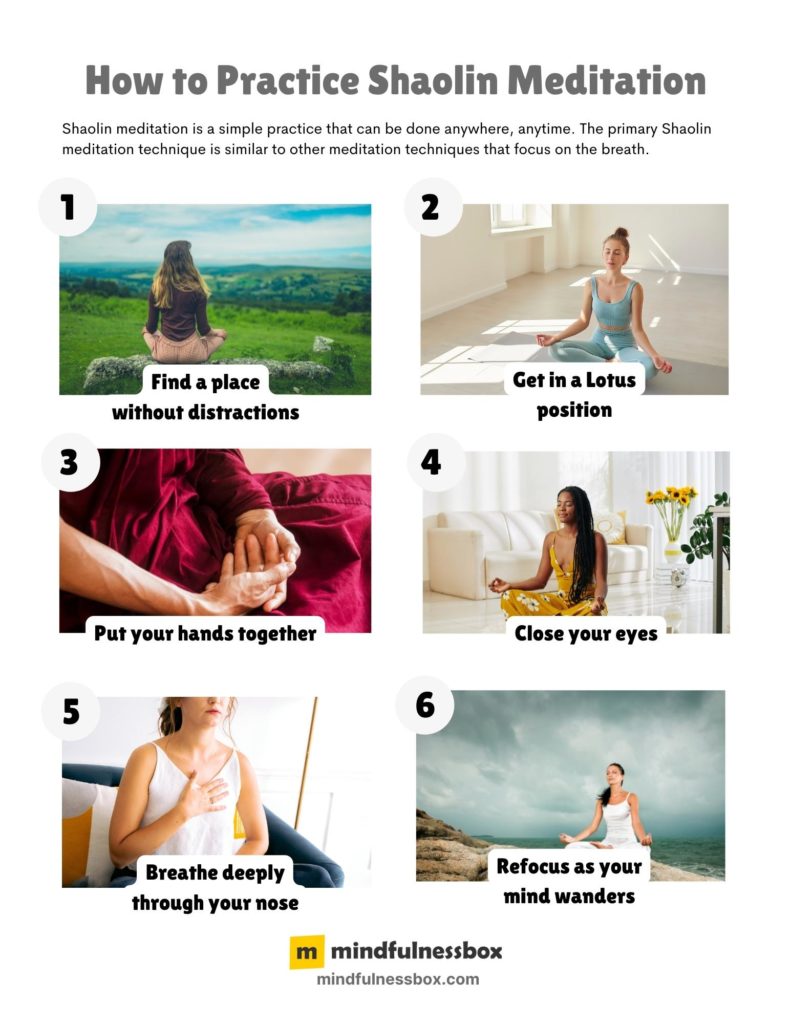
Shaolin monks practice sitting and standing meditation in the Chan Buddhist tradition.
The focus of Shaolin meditation is to cultivate peaceful energy and relieve the body and mind of anxiety, stress, and anger.
41. Six Element Meditation
Six Element meditation is an ancient Buddhist tradition that helps practitioners recognize that constant change is the natural state of the world (and everything in it).
When you practice Six Element meditation, you contemplate interconnectedness and impermanence in order to cultivate this awareness.
42. Sufi Meditation
Sufism is a branch of Islam. Sufi meditation focuses on cultivating a relationship with God through chanting and meditation. The goal of Sufi meditation is to empty the mind and purify the body and soul.
43. Tai Chi
Tai chi is sometimes referred to as ‘meditation in motion.’
Originating in ancient China, tai chi involves a series of slow, gentle movements intended to reduce stress and create a sense of calm.
44. Thai Forest Meditation
The Thai Forest tradition emerged in the 1870s and is rooted in the tradition of the Buddha, who is thought to have practiced and taught in the forest.
Monks in the Thai Forest tradition behave as Buddha did, renouncing the world, living aesthetically in nature, and depending on alms to survive.
45. Third Eye Meditation
Third eye meditation focuses on the area between the eyebrows, known as the Third Eye chakra, which is associated with intuition, knowledge, and a “sixth sense.”
By focusing on the Third Eye chakra, this meditation technique is thought to help develop intuition and wisdom.
46. Transcendental Meditation
Transcendental Meditation (TM) is a form of mantra meditation.
Each student receives personalized instruction from a TM teacher, as well as a personalized mantra to repeat.
47. Vedic Meditation
Vedic meditation is a form of mantra meditation originating in ancient India.
Rather than attempt to observe thoughts without judgment or concentrate on the breath, Vedic meditation simply focuses on the silent repetition of a mantra in order to calm the mind.
48. Vipassana
Vipassana is a form of insight meditation that’s thought to have been first taught by the Buddha as a tool to reveal the true nature of existence.
In Vipassana, your focus is on observing your thoughts and bodily sensations without judgment, and bringing your awareness back to the present moment.
Learn more about what a 10-day silent Vipassana retreat looks like here.

49. Walking Meditation
Walking meditation is a simple way to develop your awareness while out in the world. Instead of sitting on a cushion, you stand and walk.
But rather than walk on autopilot, you do so with close attention to every step and sensation that occurs: the feeling of lifting your leg, for example, or the sensation of your foot connecting with the ground.
50. Zen Koan Meditation
Zen Koan meditation involves focusing on an unanswerable question.
For example, “When both hands are clapped a sound is produced; listen to the sound of one hand clapping.”
Koans are intended to bring the analytical mind to the point of exhaustion, in order to open up space for the intuitive mind.
51. Zazen Meditation
Zazen is a form of seated meditation that involves a focus on the present moment and the breath.
Unlike many meditation techniques, the specific postures used during Zazen meditation are important, and the eyes remain half-open instead of closed during meditation. The hands are often folded in a specific posture as well.

My mindfulness practice kicked off in 2016 with a ten-day silent retreat. Since then, I’ve read dozens of books about mindfulness and completed hundreds of hours of meditation. Thinking about what makes humans happy, calm, and peaceful is endlessly fascinating to me.


